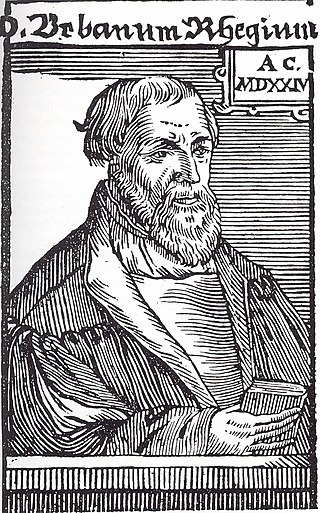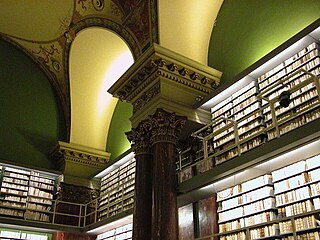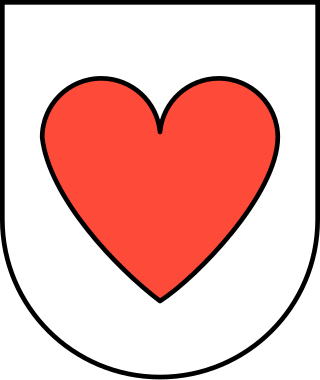Related Research Articles

"De Brevitate Vitae", more commonly known as "Gaudeamus igitur" or just "Gaudeamus", is a popular academic commercium song in many European countries, mainly sung or performed at university graduation ceremonies. Despite its use as a formal graduation hymn, it is a jocular, light-hearted composition that pokes fun at university life. The song is thought to originate in a Latin manuscript from 1287. It is in the tradition of carpe diem with its exhortations to enjoy life. It was known as a beer-drinking song in many early universities and is the official song of many schools, colleges, universities, institutions, student societies and is the official anthem of the International University Sports Federation.

Georg Rörer was a German Lutheran theologian, clergyman, Protestant reformer and stenographer of Martin Luther's sermons and lectures.

This list of books by Martin Luther contains a bibliography of the works of Martin Luther in print, online or other formats, in English translation and original language. Martin Luther resisted the publication of a combined edition of his works for multiple reasons, although he finally consented to write a preface to such a publication in 1539.
Jürgen Henkys was a German Protestant minister and theologian.

Johannes Mathesius, also called Johann Mathesius or John Mathesius, was a German minister and a Lutheran reformer. He is best known for his compilation of Martin Luther's Table Talk, or notes taken of Luther's conversation and published afterwards. He rivaled Anton Lauterbach in his diligence in notetaking, and surpassed him in the discrimination with which he arranged it.

Urbanus Henricus Rhegius or Urban Rieger was a Protestant Reformer who was active both in Northern and Southern Germany in order to promote Lutheran unity in the Holy Roman Empire. He was also a popular poet. Martin Luther referred to him as the "Bishop of Lower Saxony".

The Herzog August Library, in Wolfenbüttel, Lower Saxony, known also as Bibliotheca Augusta, is a library of international importance for its collection from the Middle Ages and early modern Europe. The library is overseen by the Lower Saxony Ministry for Science and Culture.
Johannes Baptista von Albertini was a German botanist, mycologist and clergyman of the Moravian Church. He was born in the town of Neuwied.

The Weimar edition of Luther's works, also known as the Weimarer Ausgabe (WA), is a critical complete edition of all writings of Martin Luther and his verbal statements, in Latin and German. The official title of this edition is D. Martin Luthers Werke: kritische Gesammtausgabe. Also included are Luther's Table Talk (Tischreden), Letters (Briefe), and Bible Translation. The three subseries are numbered separately.

The Uissigheim family were a minor Frankish German noble family at Uissigheim, south-east of Wertheim. The family - Arnold von Uissigheim "King Armleder", his father and his brothers - were expelled from their land for ten years in 1333 as the result of a complaint by the Count of Wertheim in 1333. Later members of the family are noted occasionally. The family coat of arms consists of a red and silver checker pattern.

Reinhard Jirgl is a German writer.
Friedrich Wilhelm Leopold Konstantin Quirin Freiherr von Forcade de Biaix, aka Friedrich Wilhelm Leopold Konstantin Quirin von Forcade de Biaix, Herr of Schleibitz, Hamm, Groß-Naedlitz and Loslau, aka the Baron von Forcade,, Royal Prussian Major, Knight of the Iron Cross 2nd Class on 26 August 1813, knighted by His Majesty Frederick William III of Prussia as Knight of the Order of Saint John in 1817, Royal Prussian Chamberlain (Kammerherr) and Castellan (Drost) of Neuenrade in the County of Mark, after his father's death in 1808. He was also a publisher, author, and theater director.
Karl Günther Ernst Felix Becker was a German art historian, best known today for the project Thieme-Becker.
Sister-books is the term for a group of texts in the medieval literature. These works were written by Dominican nuns in the first half of the fourteenth century in South Germany and Switzerland. They relate the mystical experiences of sisters within the monastery, and were influential in the development of medieval mysticism.
Wolfgang Kermer is a German art historian, artist, art educator, author, editor, curator of exhibitions, art collector and professor. From 1971 to 1984 he was repeatedly elected Rector of the State Academy of Fine Arts Stuttgart and thus the first scientific and at the same time youngest teacher in this position in the history of the university. Under his rectorate, the State Academy of Fine Arts Stuttgart was reformed in 1975 and 1978 on the base of two new university laws of the State of Baden-Württemberg and thus, for the first time in its history, authorized to set up diplomas for all courses. One of the accents of his work was the promotion of talented graduates of the academy: In 1978 he organized the first of the so-called ″debutant exhibitions″, an ″unconventional contribution to the promotion of young people″, supported financially by the State of Baden-Württemberg.

Else Hertzer (1884–1978) was a 20th-century German artist representing the German Expressionism Movement. Her later works became more abstract.
Bodo Balthasar von Dewitz was a German art historian. His work focused on historical photography.
Dietrich Meinardus was a German sculptor and stone mason of the historicism in Düsseldorf.
Johann Josef Scotti was a Prussian civil servant, publisher and writer.
References
- ↑ Hazlitt, William. "Introduction". Martin Luther's Table Talk . Retrieved 14 January 2011.
- ↑ Preserved, Smith (1907). Luther's Table Talk: A Critical Study (PDF). Columbia University Press. pp. 10–11.
- ↑ This collection was previously only published in its entirety in Georg Rörer's edition.
- ↑ A manuscript with table talk from Konrad Cordatus which was found in a library in Berlin.
- ↑ A manuscript with table talk which was found in a school library in Zwickau.
- 1 2 A manuscript with table talk which was found in a library in Wolfenbüttel.
- ↑ "Math." means Johannes Mathesius and "L." means Leipzig, because the manuscript was found in a library in Leipzig. These table talks are possibly from the 1530s.
- ↑ Manuscripts 'Clm.' are in the Bayerische Staatsbibliothek, Munich.